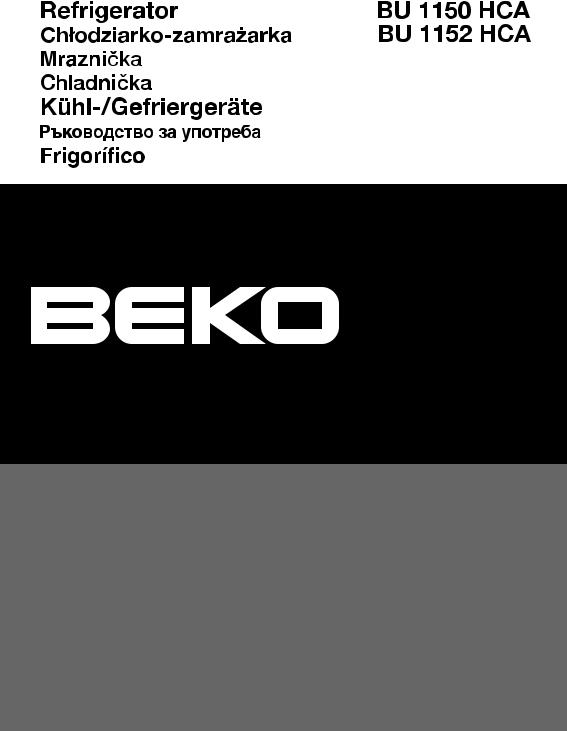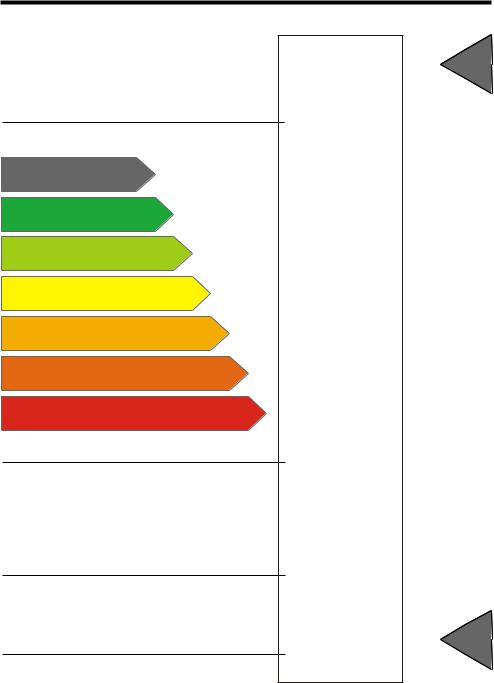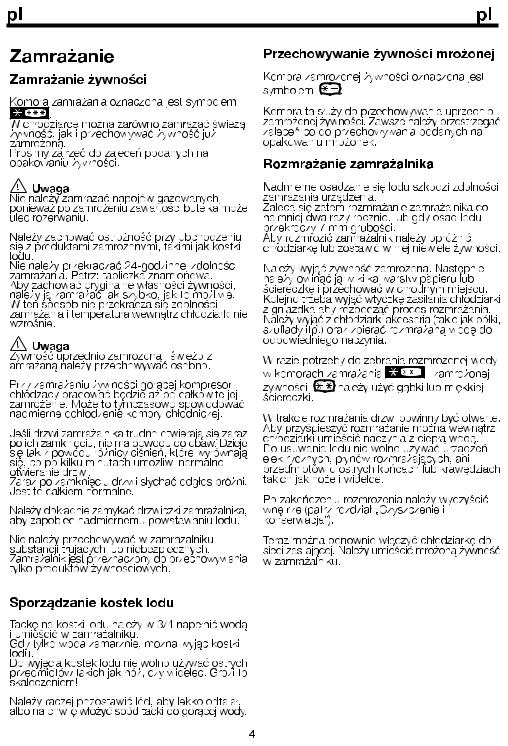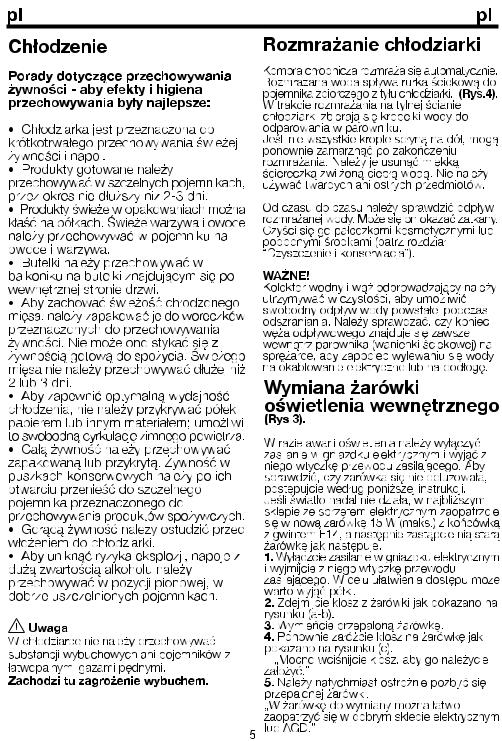Beko BU BU 1152 HCA, BU 1153, BU 1150 HCA Operating Instructions





en |
en |
|
|
Congratulations on your choice of our product which will certainly provide you with many years of good service.
Safety comes first!
Please read this Instruction Manual carefully. It contains important information on how to use your new appliance. If instructions are not adhered to, you may lose your right to service at no charge during the warranty period. Please keep this manual in a safe place and pass it on to later users if applicable.
•Do not connect your appliance to the power supply until all packing and transit protectors have been removed.
•Leave to stand upright for at least 4 hours before switching on to allow the system to settle if transported horizontally.
•This appliance must only be used for its intended purpose, i.e. the storing and freezing of edible foodstuff.
•We do not recommend use of this appliance in an unheated, cold room e.g. garage, conservatory, annex, shed, outdoors etc., see ‘Location’.
•On delivery, check to make sure that the product is not damaged and that all the parts and accessories are in perfect condition.
•Do not operate a damaged appliance if in doubt, check with your dealer.
•Do not allow children to play with the appliance.
•Do not sit or stand on, or let the children sit or stand on the appliance or on the pull-out parts.
•Do not hang on the appliance door.
•Your appliance contains no fluoridated coolants (CFC/HFC), but isobutane (R 600 a), a natural gas which is highly compatible with the environment.
(R 600 a) is easily flammable. Therefore, be sure that the cooling circuit is not damaged
either during transport or during operations. In the event of damage;
•Avoid any open flame, sources of sparks and flammable substances.
•Immediately air the room in which the appliance is located.
•In case the coolant spraying out contacts you eyes it may cause eye injuries.
•The space in the room where the appliance is installed must not be smaller than 10 cubic metres.
•Do not dispose of the appliance in a fire. Your appliance contains non CFC substances in the insulation which are flammable.
•Please contact your local authority in your region for information on disposal methods and facilities available.
 Warning - Keep ventilation openings on the appliance enclosure or in the built-in structure, clear of obstruction.
Warning - Keep ventilation openings on the appliance enclosure or in the built-in structure, clear of obstruction.
 Warning - Do not use mechanical devices or other means to accelerate the defrosting process, other than those recommended by the manufacturer.
Warning - Do not use mechanical devices or other means to accelerate the defrosting process, other than those recommended by the manufacturer.
 Warning - Do not damage the refrigerant circuit.
Warning - Do not damage the refrigerant circuit.
 Warning - Do not use electrical devices inside the food storage compartments of the appliance, unless they are of the type recommended by the manufacturer.
Warning - Do not use electrical devices inside the food storage compartments of the appliance, unless they are of the type recommended by the manufacturer.
•Avoid touching the metal condenser wiring on the backside of the appliance there is risk of injury.
•In the event of a possible malfunction, disconnect the appliance from the power supply first.
•Prior to cleaning the appliance always unplug the appliance or switch off the circuit breaker. Do not pull from the power cable. Pull from the plug.
•Repairs to the electrical equipment may only be made by qualified experts. If the power cable is damaged, the manufacturer or customer service must replace it in order to avoid danger.
•This appliance is not intended for use by persons (including children) with reduced physical, sensory or mental capabilities, or lack of experience and knowledge, unless they have been given supervision or instruction concerning use of the appliance by a person responsible for their safety.
•Children should be supervised to ensure that they do not play with the appliance.
1
en |
en |
|
|
Transport instructions
The appliance should be transported only in upright position.
The packing as supplied must be intact during transportation.
f the appliance is transported in the horizontal position, it must be placed vertically and left in this position for 4 hours before taking into operation.
The appliance must be protected against rain, moisture and other atmospheric influences. The manufacturer assumes no liability if safety instructions are disregarded.
 Disposal
Disposal
Make the appliance unusable immediately. Pull out the mains plug and cut the power cable. Remove or destroy snap or latch locks before disposing of the appliance. In this manner you prevent children from locking themselves in and endangering their lives.
Appliance setup
•Do not operate your appliance in a room where the temperature is likely to fall below 10 °C at night and/or especially in winter. At lower temperatures the appliance may not operate, resulting in a reduction in the storage life of the food.
•The climate class rate of your appliance is given on the rating label located inside the appliance. It specifies the appropriate operating ambient temperatures as explained below.
Climatic class |
Ambient temperatures |
SN....................... |
+10 °C to 32 °C |
N ......................... |
+16 °C to 32 °C |
ST ....................... |
+18 °C to 38 °C |
T.......................... |
+18 °C to 43 °C |
SN-ST ................. |
+10 °C to 38 °C |
SN-T ................... |
+10 °C to 43 °C |
Location
Only place the appliance in dry rooms which can be ventilated.
Avoid direct sunlight or direct heat sources such as a stove or a heater.
If this cannot be avoided, the following minimum distances should be maintained:
Electric stoves: |
3.00 cm |
Heater: |
3.00 cm |
Cooling devices: 2.50 cm
• Make sure that sufficient room is provided around the appliance to ensure free air circulation.
Electrical connections
 Warning
Warning
This appliance must be grounded.
•Check whether the power type and voltage your region corresponds to the one stated on the rating label inside the appliance.
•The electrical safety of the appliance is only assured when the grounding system in the house is installed in accordance with regulations.
•When placing the appliance, do not let the power cable get stuck under it; otherwise the cable will be damaged.
•Ensure that the plug remains readily accessible. Do not use a multiple adapter bar or an extension cable.
•The electrical specifications of your appliance is given on the rating label located inside the appliance.
•Route power cable to allow easy connection and disconnection after installation.
•A contact separator should be used if the power cable is not accessible.
2

en |
en |
|
|
Get to know your appliance
 Warning
Warning
Below information about accessories are supplied only for reference. Below accessories may not be exactly same as the accessories of your appliance.
Fig. 1
1. a.) Freezing compartment & ice tray (for




 models)
models)
b.) Frozen food compartment & ice tray (for  models)
models)
2.Interior light & Thermostat knob
3.Movable shelves
4.Defrost water collection channel - Drain tube
5.Crisper cover
6.Crisper
7.Door shelves
8.Egg tray
9.Bottle shelf
10.Air grill
Prior to startup
Before you start operating your appliance, the following points should be re-checked for safety:
•Is the appliance, standing level on the floor?
•Is there sufficient space for good air circulation?
•Is the interior clean? (Also see the section “Cleaning and care”)
•Set the thermostat knob half way between 1 and 5 or Min. and Max.
•Now connect the appliance to the mains.
•The compressor is turned on; the interior light comes on when the door is opened.
Do not place foodstuff into the refrigerator until the temperature has reached the desired level.
Setting the operating
temperature
(Fig. 2)
The operating temperature is regulated by the temperature control.
Warm |
|
|
|
Cold |
1 |
2 |
3 |
4 |
5 |
(Or) Min. |
|
|
|
Max. |
1 = Lowest cooling setting (Warmest setting)
5 = Highest cooling setting (Coldest setting)
(Or)
Min. = Lowest cooling setting
(Warmest setting)
Max. = Highest cooling setting
(Coldest setting)
The average temperature inside the fridge should be around +5°C.
Please choose the setting according to the desired temperature.
You can stop operation of your appliance by turning the thermostat knob to “0” position.
Please note that there will be different temperatures in the cooling area.
The coldest region is immediately above the vegetable compartment.
The interior temperature also depends on ambient temperature, the frequency with which the door is opened and the amount of food kept inside.
Frequently opening the door causes the interior temperature to rise.
For this reason, it is recommended to close the door again as soon as possible after use.
3

en |
en |
|
|
Freezing
Freezing food
The freezing compartment is marked with
 this symbol.
this symbol.
You can use the appliance for freezing fresh food as well as for storing pre-frozen food. Please refer to the recommendations given on the packaging of your food.
 Attention
Attention
Do not freeze fizzy drinks, as the bottle may burst when the liquid in it is frozen.
Be careful with frozen products such as coloured ice-cubes.
Do not exceed the freezing capacity of your appliance in 24 hours. See the rating label. In order to maintain the quality of the food, the freezing must be effected as rapidly as possible. Thus, the freezing capacity will not be exceeded, and the temperature inside the freezer will not rise.
 Attention
Attention
Keep the already deep-frozen food always separated with freshly placed food.
When deep-freezing hot food, the cooling compressor will work until the food is completely frozen. This can temporarily cause excessive cooling of the refrigeration compartment.
If you find the freezer door difficult to open just after you have closed it, don’t worry. This is due to the pressure difference which will equalize and allow the door to open normally after a few minutes.
You will hear a vacuum sound just after closing the door. This is quite normal.
Making ice cubes
Fill the ice-cube tray 3/4 full with water and place it in the freezer.
As soon as the water has turned into ice, you can take out the ice cubes.
Never use sharp objects such as knives or forks to remove the ice cubes. There is a risk of injury!
Let the ice cubes slightly thaw instead, or put the bottom of the tray in hot water for a short moment.
Storing frozen food
The frozen food compartment is marked with  symbol.
symbol.
The frozen food compartment is suitable for the storage of pre-frozen food. The recommendation for storage, as stated on the food packaging, should be observed at all times.
Defrosting of the appliance
Excessive build-up of ice will affect the freezing performance of your device.
It is therefore recommended that you defrost your appliance at least twice a year, or whenever the ice build-up exceeds 7 mm. Defrost your device when there is only little or no food in it.
Take out the deep-frozen food. Wrap the deepfrozen food in several layers of paper, or a blanket, and keep it in a cold place.
Unplug the appliance or switch off the circuit breaker to start the defrosting process. Take out the accessories (like shelf, drawer etc.) from the appliance and use a suitable container to collect the thawing water.
Use a sponge or a soft cloth to remove thawing water if necessary at the freezing compartment
 and frozen food compartment
and frozen food compartment
Keep the door open during defrosting.
For quicker defrosting, place containers with warm water inside the appliance.
Never use electrical devices, defrosting sprays or pointed or sharp-edged objects such as knives or forks to remove the ice.
After the defrosting is done, clean the inside (see the section “Cleaning and Care”).
Reconnect the appliance to the mains. Place the frozen food into the drawers and slide the drawers into the freezer.
4
en |
en |
|
|
Cooling
Food storage
The fridge compartment is for the short-term storage of fresh food and drinks.
Store milk products in the intended compartment in the refrigerator.
Bottles can be stored in the bottle holder or in the bottle shelf of the door.
Raw meat is best kept in a polyethylene bag in the compartment at the very bottom of the refrigerator.
Allow hot food and beverages to cool to room temperature prior to placing them in the refrigerator.
 Attention
Attention
Store concentrated alcohol in a container only standing upright and tightly closed.
 Attention
Attention
Do not store explosive substances or containers with flammable propellant gases (canned cream, spray cans etc.) in the appliance.
There is a danger of explosion.
Defrosting of the appliance
The fridge compartment defrosts automatically. The thawing water flows through the drain channel into a collection container at the back of the appliance (Fig. 4).
During defrosting, water droplets form at the back wall of the fridge due to the evaporation. If not all of the drops run down, they may freeze again after defrosting competes. Remove them with a soft cloth dampened with warm water. Do not use hard or sharp objects.
Check the flow of the thawed water from time to time. It may become blocked occasionally. Clean it with a q-tip or similar (see the section "Cleaning and care").
Replacing the interior light bulb
(Fig. 5)
Should the light fail to work switch off at the socket outlet and pull out the mains plug. Follow the below instructions to check if the light bulb has worked itself loose.
If the light still fails to work obtain a replacement E14 screw cap type 15 Watt (Max) bulb from your local electrical store and then fit it as follows:
1.Switch off at the socket outlet and pull out the mains plug. You may find it useful to remove shelves for easy access.
2.Remove the light diffuser cover as shown in figure (a-b).
3.Replace the burnt-out light bulb.
4.Reassemble the light diffuser cover as shown in figure (c).
“Push firmly to ensure cover is fitted properly.”
5.Carefully dispose of the burnt-out light bulb immediately.
"Replacement light bulb can easily be obtained from a good local electrical or DIY store."
5
en |
en |
|
|
Cleaning and care
Interior and Exterior Surfaces
 Attention
Attention
Always unplug the power cable or switch off the circuit breaker before cleaning.
Clean the exterior using lukewarm water and a mild detergent.
Never use detergents, abrasive or acidic agents.
Wipe the inside compartment dry.
Be careful to prevent water from getting into contact with the electrical connections of the temperature control or the interior light.
If the appliance is not going to be used for a long period of time, unplug the power cable remove all food. Clean the appliance and keep the door open.
To preserve the appearance of your appliance, you can polish the exterior and the door accessories with a silicone wax.
Clean the condenser at the back of the appliance once a year using a brush or a vacuum cleaner. Dust build-up leads to increased energy consumption.
Inspect the door gasket at regular intervals. Clean with water only, and wipe totally dry.
Cleaning of the accessories
Door shelves:
Remove all food from the door shelves.
Lift the cover of the shelf upwards and pull it off sideward.
Remove the door shelf by pushing it upwards from the bottom.
Crisper or Drawers:
To clean a drawer, pull it out as far as possible, tilt it upwards and then pull it out completely.
Practical tips and notes
Cooling
•Clean fresh food and vegetables before storing in the crisper bin.
•Always pack or wrap food, or put it in a suitable container, before storing it in the appliance.
•Wrap food which is not suitable for storage at cold temperatures in polyethylene bags (pineapple, melons, cucumbers, tomatoes etc.).
•Food with strong odour or apt to acquire odour should be wrapped in airtight or smellproof packaging material.
•Keep fresh food separate from cooked food, to avoid bacteria contamination.
•Never keep fresh meat in the fridge for more than 2 or 3 days.
•Remove any left-over canned food from the can and store it in a suitable container.
•Refer to the shelf life indicated on the
food packaging.
•Do not obstruct the air circulation inside the appliance by covering the shelves.
•Never keep any dangerous or poisonous substances inside your appliance.
•Always check food that has been stored for a long period of time for its suitability for consumption.
•Do not store fresh and cooked food together in the same container.
•Close the door immediately after opening, to avoid unnecessary energy consumption.
•Do not use hard or sharp objects to remove the ice build-up.
•Do not load hot food into your appliance.
6
en |
en |
|
|
|
|
Examples of Use |
|
|
|
|
|
White wine, beer and mineral water |
chill before use |
|
Bananas |
do not store in a fridge |
|
|
|
|
Fish or offal |
store in polyethylene bags only |
|
|
|
|
|
use airtight containers or polyethylene |
|
Cheese |
bags; for best results, take out from the |
|
|
|
|
|
fridge an hour before consumption. |
|
|
|
|
Melons |
store only for a short period of time, |
|
|
|
|
|
use airtight packaging/wrapping |
|
|
|
|
|
do not store together with delicate |
|
Raw meat and poultry |
|
|
|
food such as cooked food or milk |
|
|
|
|
Normal operating noises
Various functional noises are completely normal due to the operation of the cooling system of your appliance;
•Gurgling, hissing, boiling or bubbling noises are caused by the refrigerant, circulating inside the cooling system. These noises can still be heard for a short period of time after the compressor shuts off.
•Sudden, sharp cracking or popping noises are caused by the expansion and contraction of the inside walls or some components inside the cabinets.
•Buzzing, whirring, pulsating or high-pitched humming noises are caused by the compressor. These noises are slightly louder at the start-up of the compressor and reduce when the appliance reaches the operating temperatures.
Also to avoid disturbing vibrations and noises make sure that;
•Your refrigerator is standing level on all four feet.
•Cans, bottles or dishes inside the refrigerator are not touching and hitting each other.
•All shelves and bins are mounted correctly inside the refrigerator cabinets and doors.
7

en |
en |
|
|
What, if....
1- The appliance will not work, even though it is switched on.
•Check if the power cable is properly connected!
•Check if the mains supply is in order, or if a circuit breaker has been tripped!
•Check the temperature control for correct setting!
2- There is a power failure.
Your freezer is suitable for the long-term storage of frozen food that are available commercially and also can be used to freeze and store fresh food.
Do not open the door in case of a power failure.
For a rated appliance, frozen food in the freezer compartment will not be affected if the power failure lasts shorter than the “Conservation Time From Failure (hours)” mentioned in the rating label.
rated appliance, frozen food in the freezer compartment will not be affected if the power failure lasts shorter than the “Conservation Time From Failure (hours)” mentioned in the rating label.
If the power failure is longer than the “Conservation Time From Failure (hours)”, then the food should be checked and either consumed immediately or cooked and then re-frozen.
3- The interior light does not work.
Check the power supply!
Check the installation of the light bulb! Unplug the power cable before checking the light bulb. (Also see the section “Replacing the interior light bulb”)
4- Other possible malfunctions
Not every malfunction is a case for our customer service. Very often, you can easily resolve the problem without requesting service. Before requesting service, please check if the malfunction has been caused by an operating error. If this is the case, and a service has been requested, a service charge will be levied even if the appliance is still under guarantee.
If the problem persists please contact your dealer or customer service.
Please have the type and serial number of your appliance when calling. The rating label is located inside the appliance.
Reversing the doors
Proceed in numerical order (Fig. 5).
Recycling This product bears the selective sorting symbol for waste electrical and electronic equipment (WEEE).  This means that this product must be handled pursuant to European Directive 2002/96/EC in order to be recycled or dismantled to minimize its impact on the environment. For further information, please contact your local or regional authorities.
This means that this product must be handled pursuant to European Directive 2002/96/EC in order to be recycled or dismantled to minimize its impact on the environment. For further information, please contact your local or regional authorities.
Electronic products not included in the selective sorting process are potentially dangerous for the environment and human heatlh due to the presence of hazardous substances.
8

Meaning of energy fiche (Only for information purpose)
Energy
Manufacturer
Model
More efficient
A
B
C
D
E
F
G
Less efficient
Energy consumption kWh/year
(Based on standard test results for 24 h)
Actual comsumption will depend on how the appliance is used and where it is located
Fresh food volume l
Frozen food volume l
Chill compartment volume l
Noise
(dB(A) re 1 pW)
en
You may stick the energy fiche given in the polybag to the area above.
9









